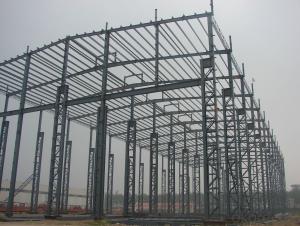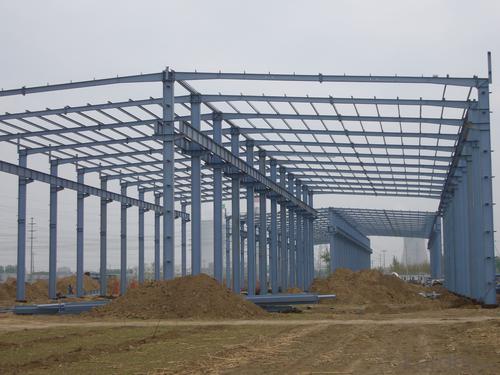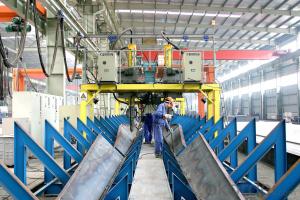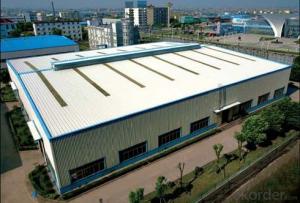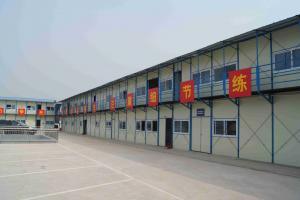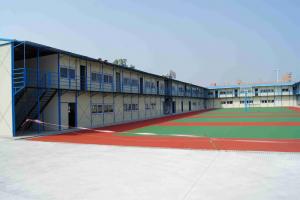Famous brand carbon prefabricated steel structure
- Loading Port:
- China Main Port
- Payment Terms:
- TT OR LC
- Min Order Qty:
- -
- Supply Capability:
- -
OKorder Service Pledge
OKorder Financial Service
You Might Also Like
Steel Structure Building
1.the connection method of steel structure:
welding connection or bolt connection
2.Steel structure design common norms are as follows:
"Steel Design Code" (GB50017-2003)
"Cold-formed steel structure technical specifications" (GB50018-2002)
"Construction Quality Acceptance of Steel" (GB50205-2001)
"Technical Specification for welded steel structure" (JGJ81-2002, J218-2002)
"Technical Specification for Steel Structures of Tall Buildings" (JGJ99-98)
3.The characteristics of steel
Light weight steel structure
Higher reliability of steel work
Steel anti-vibration (earthquake), impact and good
Steel structure for a higher degree of industrialization
Steel can be assembled quickly and accurately
Large steel interior space
Likely to cause sealing structure
Steel corrosive
Poor fire-resistant steel
Recyclable steel
Steel shorter duration
4.Commonly used steel grades and performance of steel
Carbon structural steel: Q195, Q215, Q235, Q255, Q275, Q345,etc.
High-strength low-alloy structural steel
Quality carbon structural steel and alloy structural steel
Special purpose steel
5.Market:
Products have been all over the country more than 20 provinces, municipalities and autonomous regions, and have been exported to Europe, North America, the Middle East, Africa, Asia and other countries and regions, the widespread use
- Q: How are steel structures used in the construction of oil and gas refineries?
- Due to their strength, durability, and versatility, steel structures find extensive use in the construction of oil and gas refineries. They play a crucial role in supporting various components and equipment involved in the refining process. A primary application of steel structures in refineries is the construction of storage tanks. Steel is an ideal material for these tanks as it can withstand the corrosive nature of the chemicals and substances stored within. Moreover, steel tanks have the capability to endure high pressures, making them suitable for storing vast quantities of oil and gas. In addition, steel structures are employed for the construction of pipe racks, which provide support for the extensive network of pipes used to transport fluids throughout the refinery. These pipe racks are typically elevated to ensure efficient pipe routing and to minimize the risk of damage or interference with other equipment. Steel is also utilized for the construction of platforms and walkways within refineries. These structures facilitate access to various areas of the refinery, enabling safe and efficient maintenance and inspection activities. The high strength-to-weight ratio of steel makes it an ideal material for these structures, as it can bear heavy loads while minimizing overall construction weight. Furthermore, steel structures find application in the construction of process units and equipment supports. These structures serve as stable foundations for various equipment, including reactors, distillation columns, heat exchangers, and pumps. The robustness of steel allows it to withstand the dynamic forces and vibrations generated by such equipment, ensuring their safe and reliable operation. In conclusion, the strength, durability, and versatility of steel structures make them indispensable in the construction of oil and gas refineries. They provide crucial support for storage tanks, pipe racks, platforms, and equipment supports, enabling the efficient and safe operation of the refining process.
- Q: What are the design considerations for steel stadiums?
- Design considerations for steel stadiums involve several key factors that are essential for the successful construction and functionality of the structure. These considerations include: 1. Structural integrity: One of the primary design considerations for steel stadiums is ensuring the structural integrity of the entire building. Steel is a strong and durable material, but it must be carefully designed to withstand various loads, including the weight of the roof, seating, and other equipment. The design should account for potential hazards such as wind, earthquakes, and snow loads to ensure the safety of occupants. 2. Material selection: Steel is the preferred material for stadium construction due to its strength, versatility, and cost-effectiveness. Designers must select the appropriate grade and thickness of steel to suit the specific requirements of the project. Factors such as corrosion resistance, fire resistance, and ease of fabrication should also be considered during material selection. 3. Roof design: The design of the stadium roof is crucial for providing shelter and protecting spectators from weather conditions. The roof structure should be designed to accommodate various roof types, including retractable roofs or domes, depending on the specific requirements of the stadium. The roof design should also allow for efficient rainwater drainage and proper insulation to maintain a comfortable environment inside the stadium. 4. Seating arrangement: The seating arrangement of a stadium is a critical design consideration as it directly affects the spectator's experience. The design should maximize the number of seats while ensuring clear sightlines to the playing field and maintaining adequate spacing for comfort and safety. Accessibility for disabled individuals should also be considered, ensuring easy access to seating areas and facilities. 5. Acoustics and noise control: Steel stadiums often host events with loud crowds and amplified sound systems. Designing the stadium to optimize acoustics and minimize noise levels is essential for creating an enjoyable experience for spectators and performers. The design should include sound-absorbing materials, proper speaker placement, and noise control measures to reduce echoes and ensure clear and balanced sound throughout the stadium. 6. Sustainability: In today's environmentally conscious world, the design of steel stadiums should also consider sustainability factors. This includes incorporating energy-efficient systems, utilizing renewable energy sources, and implementing strategies for waste management and water conservation. The selection of sustainable materials and construction practices can also contribute to reducing the environmental impact of the stadium. Designing steel stadiums requires a comprehensive approach that takes into account various considerations ranging from structural integrity and material selection to seating arrangement, acoustics, and sustainability. By carefully considering these factors, designers can create state-of-the-art stadiums that provide a safe, comfortable, and enjoyable experience for spectators while meeting the needs of the modern sports industry.
- Q: How do steel structures perform in terms of flexibility for future modifications?
- Steel structures perform exceptionally well in terms of flexibility for future modifications. Due to their inherent strength and versatility, steel buildings can easily accommodate changes in layout, expansion, or retrofitting. The use of steel allows for effortless removal or addition of walls, columns, and other structural elements, ensuring that the building can adapt to evolving needs without compromising its integrity. This flexibility makes steel structures highly desirable for businesses or organizations that anticipate future modifications or expansions.
- Q: How are steel structures designed for efficient use of natural ventilation and heating?
- Steel structures can be designed to maximize the efficient use of natural ventilation and heating through various techniques. One of the key considerations in designing steel structures for natural ventilation is the incorporation of openings such as windows, vents, and louvers. These openings allow for the free flow of air, facilitating cross-ventilation and ensuring a constant supply of fresh air. To optimize natural heating, steel structures can be designed with features that capture and utilize solar energy. This can be achieved through the strategic placement of windows and skylights to allow sunlight to penetrate the interior spaces. Additionally, thermal mass materials such as concrete or stone can be incorporated into the structure to absorb and store solar heat during the day, releasing it during the cooler evenings. Another way to enhance natural ventilation and heating in steel structures is by implementing passive design strategies. These include using building orientation to maximize exposure to prevailing winds, as well as utilizing natural landscape features such as trees and vegetation for windbreaks or to provide shade during the summer months. Furthermore, the use of insulated building envelopes, such as insulated metal panels, can significantly improve the energy efficiency of steel structures. These panels help to regulate the indoor temperature by minimizing heat transfer through the walls and roof, reducing the need for artificial heating or cooling. Lastly, smart control systems can be integrated into the design of steel structures to optimize natural ventilation and heating. These systems can monitor indoor and outdoor conditions, automatically adjusting window openings, louvers, or blinds to allow for optimal airflow and heat exchange. In conclusion, the efficient use of natural ventilation and heating in steel structures can be achieved through the thoughtful integration of openings, passive design strategies, thermal mass materials, insulated building envelopes, and smart control systems. These design considerations not only enhance comfort and indoor air quality but also contribute to energy savings and environmental sustainability.
- Q: How are steel structures inspected and maintained?
- Steel structures are inspected and maintained through a combination of visual inspections, non-destructive testing techniques, and regular maintenance procedures. Visual inspections involve examining the structure for signs of corrosion, cracks, or other damages, while non-destructive testing techniques like ultrasonic testing or magnetic particle inspection can be used to detect hidden defects. Regular maintenance procedures, such as cleaning, painting, and applying protective coatings, are also carried out to prevent corrosion and ensure the structural integrity of the steel components.
- Q: How do steel structures handle soil settlement and subsidence?
- Steel structures are able to handle soil settlement and subsidence by being designed to accommodate these movements. Firstly, steel structures are often built on deep foundations, such as piles, that can withstand the settlement and subsidence of the soil. Additionally, steel is a flexible material that can tolerate some degree of movement without significant damage or structural failure. This flexibility allows the steel structure to distribute the load evenly, minimizing the impact of soil movement. Moreover, steel structures can be designed with adjustable connections and joints that can be tightened or loosened to adapt to the changing conditions of the soil. Overall, steel structures are engineered to be resilient and adaptable, making them well-suited to withstand soil settlement and subsidence.
- Q: What is the role of steel in cultural and recreational buildings?
- Cultural and recreational buildings heavily rely on steel, serving both functional and aesthetic purposes. Primarily, architects and engineers widely employ steel in these constructions due to its impressive strength-to-weight ratio. This characteristic empowers them to design expansive areas, like auditoriums, exhibition halls, or sports arenas, without excessive columns or support structures. The ability of steel to span long distances enables the creation of extensive interiors, offering flexibility in layout and accommodating various activities or exhibits. Additionally, steel's flexibility allows for the development of unique architectural designs and iconic structures that become cultural landmarks. From the Eiffel Tower to the Sydney Opera House, steel has played a pivotal role in shaping the character and identity of cultural buildings worldwide. Its malleability permits the creation of intricate and imaginative shapes, making it a preferred material for constructing visually striking and memorable structures. Moreover, steel's durability and ability to withstand fire, earthquakes, and other natural disasters assure the safety and long-term sustainability of cultural and recreational buildings. This is particularly important as these buildings often host large crowds and house valuable cultural artifacts or equipment. Furthermore, steel's recyclability and sustainability make it an environmentally friendly choice for construction. The capacity to recycle steel reduces the dependence on raw materials and minimizes the carbon footprint associated with the construction industry. In summary, steel's strength, versatility, and aesthetic appeal make it an indispensable material in cultural and recreational buildings. Its use allows for the construction of large, open spaces, iconic designs, and safe and sustainable structures that contribute to the cultural and recreational experiences of individuals and communities.
- Q: What are the advantages of using steel in the construction of parking garages?
- There are several advantages of using steel in the construction of parking garages. Firstly, steel is a highly durable and strong material, which makes it capable of bearing heavy loads and resisting external forces. This attribute ensures the structural integrity and safety of the parking garage, even in harsh weather conditions or seismic zones. Additionally, steel's flexibility allows for efficient and innovative design options, enabling the construction of spacious and column-free parking spaces. Moreover, steel has a high strength-to-weight ratio, making it a lightweight material in comparison to other construction options. This allows for faster construction, reduced foundation requirements, and cost savings. Furthermore, steel is a sustainable choice as it is recyclable and can be repurposed, reducing environmental impact. Overall, the use of steel in the construction of parking garages offers durability, versatility, cost-effectiveness, and sustainability.
- Q: What are the common design considerations for steel roof structures?
- Some common design considerations for steel roof structures include the load-bearing capacity of the steel members, resistance to weather and environmental conditions, proper drainage system to prevent water pooling, thermal expansion and contraction, fire resistance, ease of installation and maintenance, and compatibility with other building components such as walls and foundations. Additionally, aesthetic considerations and cost-effectiveness are also important factors in the design process.
- Q: What are the considerations when designing steel structures for agricultural processing plants?
- When designing steel structures for agricultural processing plants, there are several key considerations that need to be taken into account. Firstly, the structural integrity and strength of the steel must be carefully assessed to ensure it can withstand the unique demands and loads associated with agricultural processing activities. Additionally, proper ventilation and airflow systems must be incorporated to maintain optimal air quality and prevent the buildup of dust or harmful gases. The layout and design should also prioritize efficient workflow and ease of maintenance, with attention to factors such as equipment placement, access points, and drainage systems. Finally, considerations for future expansion or modification should be accounted for to accommodate potential growth or changes in processing needs.
Send your message to us
Famous brand carbon prefabricated steel structure
- Loading Port:
- China Main Port
- Payment Terms:
- TT OR LC
- Min Order Qty:
- -
- Supply Capability:
- -
OKorder Service Pledge
OKorder Financial Service
Similar products
Hot products
Hot Searches


